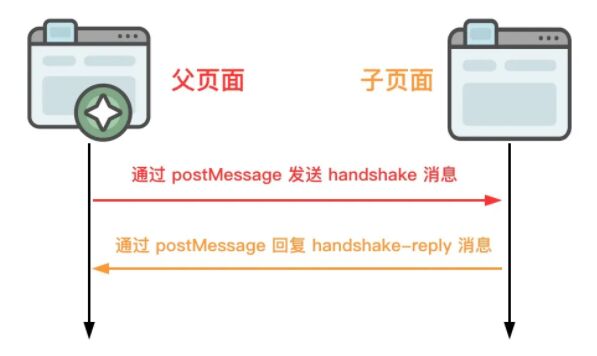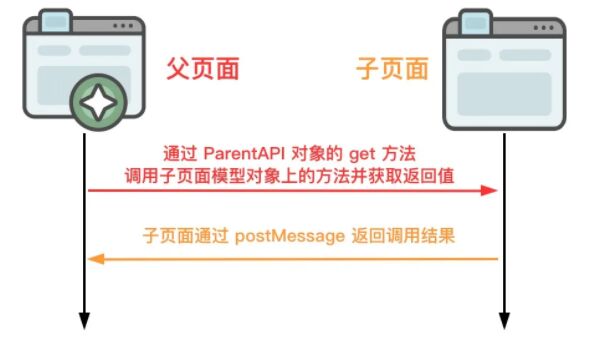在日常工作中,消息通信是一个很常见的场景。比如大家熟悉 B/S 结构,在该结构下,浏览器与服务器之间是基于 HTTP 协议进行消息通信:

然而除了 HTTP 协议之外,在一些对数据实时性要求较高的场景下,我们会使用 WebSocket 协议来完成消息通信:

对于这两种场景,相信大家都不会陌生。接下来,阿宝哥将介绍消息通信的另外一种场景,即父页面与 iframe 加载的子页面之间,如何进行消息通信。
为什么会突然写这个话题呢?其实是因为在近期项目中,阿宝哥需要实现父页面与 iframe 加载的子页面之间的消息通信。另外,刚好近期阿宝哥在写 源码分析 专题,所以就到 Github 上搜索 🔍 了一番,然后找到了一个不错的项目 —— Postmate。
在阅读完 Postmate 源码之后,阿宝哥觉得该项目的一些设计思想挺值得借鉴的,所以就写了这篇文章来跟大家分享一下。阅读完本文之后,你将学到以下知识:
- 消息系统中握手的作用及如何实现握手;
- 消息模型的设计及如何实现消息验证来保证通信安全;
- postMessage 的使用及如何利用它实现父子页面的消息通信;
- 消息通信 API 的设计与实现。
好的,废话不多说,我们先来简单介绍一下 Postmate。
一、Postmate 简介
Postmate 是一个强大,简单,基于 Promise 的 postMessage 库。它允许父页面以最小的成本与跨域的子 iframe 进行通信。该库拥有以下特性:
- 基于 Promise 的 API,可实现优雅而简单的通信;
- 使用 消息验证 来保护双向 父 <-> 子 消息通信的安全;
- 子对象公开父对象可以访问的可检索的模型对象;
- 子对象可派发父对象已监听的事件;
- 父对象可以调用子对象中的函数;
- 零依赖。如果需要可以为 Promise API 提供自定义 polyfill 或抽象;
- 轻量,大小约 1.6 KB(minified & gzipped)。
接下来阿宝哥将从如何进行握手、如何实现双向消息通信和如何断开连接,这三个方面来分析一下 Postmate 这个库。另外,在此期间还会穿插介绍 Postmate 项目中一些好的设计思路。
二、如何进行握手
TCP 建立连接的时候,需要进行三次握手。同样,当父页面与子页面通信的时候,Postmate 也是通过 “握手” 来确保双方能正常通信。因为 Postmate 通信的基础是基于 postMessage,所以在介绍如何握手之前,我们先来简单了解一下 postMessage API。
2.1 postMessage 简介
对于两个不同页面的脚本,只有当执行它们的页面位于具有相同的协议、端口号以及主机时,这两个脚本才能相互通信。window.postMessage() 方法提供了一种受控机制来规避此限制,只要正确的使用,这种方法就很安全。
2.1.1 postMessage() 语法
- otherWindow.postMessage(message, targetOrigin, [transfer]);
- otherWindow:其他窗口的一个引用,比如 iframe 的 contentWindow 属性、执行 window.open 返回的窗口对象等。
- message:将要发送到其他 window 的数据,它将会被结构化克隆算法序列化。
- targetOrigin:通过窗口的 origin 属性来指定哪些窗口能接收到消息事件,其值可以是字符串 "*"(表示无限制)或者一个 URI。
- transfer(可选):是一串和 message 同时传递的 Transferable 对象。这些对象的所有权将被转移给消息的接收方,而发送一方将不再保有所有权。
发送方通过 postMessage API 来发送消息,而接收方可以通过监听 message 事件,来添加消息处理回调函数,具体使用方式如下:
- window.addEventListener("message", receiveMessage, false);
- function receiveMessage(event) {
- let origin = event.origin || event.originalEvent.origin;
- if (origin !== "http://semlinker.com") return;
- }
2.2 Postmate 握手的实现
在电信和微处理器系统中,术语握手(Handshake,亦称为交握)具有以下含义:
- 在数据通信中,由硬件或软件管理的事件序列,在进行信息交换之前,需要对操作模式的状态互相达成协定。
- 在接收站和发送站之间建立通信参数的过程。
对于通信系统来说,握手是在通信电路建立之后,信息传输开始之前。握手用于达成参数,如信息传输率,字母表,奇偶校验, 中断过程,和其他协议特性。
而对于 Postmate 这个库来说,握手是为了确保父页面与 iframe 子页面之间可以正常的通信,对应的握手流程如下所示:

在 Postmate 中,握手消息是由父页面发起的,在父页面中要发起握手信息,首先需要创建 Postmate 对象:
- const postmate = new Postmate({
- container: document.getElementById('some-div'), // iframe的容器
- url: 'http://child.com/page.html', // 包含postmate.js的iframe子页面地址
- name: 'my-iframe-name' // 用于设置iframe元素的name属性
- });
在以上代码中,我们通过调用 Postmate 构造函数来创建 postmate 对象,在 Postmate 构造函数内部含有两个主要步骤:设置 Postmate 对象的内部属性和发送握手消息:

以上流程图对应的代码相对比较简单,这里阿宝哥就不贴详细的代码了。感兴趣的小伙伴可以阅读 src/postmate.js 文件中的相关内容。为了能够响应父页面的握手信息,我们需要在子页面中创建一个 Model 对象:
- const model = new Postmate.Model({
- // Expose your model to the Parent. Property values may be functions, promises, or regular values
- height: () => document.height || document.body.offsetHeight
- });
其中 Postmate.Model 构造函数的定义如下:
- // src/postmate.js
- Postmate.Model = class Model {
- constructor(model) {
- this.child = window;
- this.model = model;
- this.parent = this.child.parent;
- return this.sendHandshakeReply();
- }
- }
在 Model 构造函数中,我们可以很清楚地看到调用 sendHandshakeReply 这个方法,这里我们只看核心的代码:

现在我们来总结一下父页面和子页面之间的握手流程:当子页面加载完成后,父页面会通过 postMessage API 向子页面发送 handshake 握手消息。在子页面接收到 handshake握手消息之后,同样也会使用 postMessage API 往父页面回复 handshake-reply 消息。
另外,需要注意的是,为了保证子页面能收到 handshake 握手消息,在 sendHandshake方法内部会启动一个定时器来执行发送操作:
- // src/postmate.js
- class Postmate {
- sendHandshake(url) {
- return new Postmate.Promise((resolve, reject) => {
- const loaded = () => {
- doSend();
- responseInterval = setInterval(doSend, 500);
- };
- if (this.frame.attachEvent) {
- this.frame.attachEvent("onload", loaded);
- } else {
- this.frame.addEventListener("load", loaded);
- }
- this.frame.src = url;
- });
- }
- }
当然为了避免发送过多无效的握手信息,在 doSend 方法内部会限制最大的握手次数:
- const doSend = () => {
- attempt++;
- this.child.postMessage(
- {
- postmate: "handshake",
- type: messageType,
- model: this.model,
- },
- childOrigin
- );
- // const maxHandshakeRequests = 5;
- if (attempt === maxHandshakeRequests) {
- clearInterval(responseInterval);
- }
- };
在主应用和子应用双方完成握手之后,就可以进行双向消息通信了,下面我们来了解一下如何实现双向消息通信。
三、如何实现双向消息通信
在调用 Postmate 和 Postmate.Model 构造函数之后,会返回一个 Promise 对象。而当 Promise 对象的状态从 pending 变为 resolved 之后,就会分别返回 ParentAPI 和 ChildAPI 对象:
Postmate
- // src/postmate.js
- class Postmate {
- constructor({
- container = typeof container !== "undefined" ? container : document.body,
- model, url, name, classListArray = [],
- }) {
- // 省略设置 Postmate 对象的内部属性
- return this.sendHandshake(url);
- }
- sendHandshake(url) {
- // 省略部分代码
- return new Postmate.Promise((resolve, reject) => {
- const reply = (e) => {
- if (!sanitize(e, childOrigin)) return false;
- if (e.data.postmate === "handshake-reply") {
- return resolve(new ParentAPI(this));
- }
- return reject("Failed handshake");
- };
- });
- }
- }
ParentAPI
- class ParentAPI{
- +get(property: any) // 获取子页面中Model对象上的property属性上的值
- +call(property: any, data: any) // 调用子页面中Model对象上的方法
- +on(eventName: any, callback: any) // 监听子页面派发的事件
- +destroy() // 移除事件监听并删除iframe
- }
Postmate.Model
- // src/postmate.js
- Postmate.Model = class Model {
- constructor(model) {
- this.child = window;
- this.model = model;
- this.parent = this.child.parent;
- return this.sendHandshakeReply();
- }
- sendHandshakeReply() {
- // 省略部分代码
- return new Postmate.Promise((resolve, reject) => {
- const shake = (e) => {
- if (e.data.postmate === "handshake") {
- this.child.removeEventListener("message", shake, false);
- return resolve(new ChildAPI(this));
- }
- return reject("Handshake Reply Failed");
- };
- this.child.addEventListener("message", shake, false);
- });
- }
- };
ChildAPI
- class ChildAPI{
- +emit(name: any, data: any)
- }
3.1 子页面 -> 父页面
3.1.1 子页面发送消息
- const model = new Postmate.Model({
- // Expose your model to the Parent. Property values may be functions, promises, or regular values
- height: () => document.height || document.body.offsetHeight
- });
- model.then(childAPI => {
- childAPI.emit('some-event', 'Hello, World!');
- });
在以上代码中,子页面可以通过 ChildAPI 对象提供的 emit 方法来发送消息,该方法的定义如下:
- export class ChildAPI {
- emit(name, data) {
- this.parent.postMessage(
- {
- postmate: "emit",
- type: messageType,
- value: {
- name,
- data,
- },
- },
- this.parentOrigin
- );
- }
- }
3.1.2 父页面监听消息
- const postmate = new Postmate({
- container: document.getElementById('some-div'), // iframe的容器
- url: 'http://child.com/page.html', // 包含postmate.js的iframe子页面地址
- name: 'my-iframe-name' // 用于设置iframe元素的name属性
- });
- postmate.then(parentAPI => {
- parentAPI.on('some-event', data => console.log(data)); // Logs "Hello, World!"
- });
在以上代码中,父页面可以通过 ParentAPI 对象提供的 on 方法来注册事件处理器,该方法的定义如下:
- export class ParentAPI {
- constructor(info) {
- this.parent = info.parent;
- this.frame = info.frame;
- this.child = info.child;
- this.events = {};
- this.listener = (e) => {
- if (!sanitize(e, this.childOrigin)) return false;
- // 省略部分代码
- if (e.data.postmate === "emit") {
- if (name in this.events) {
- this.events[name].forEach((callback) => {
- callback.call(this, data);
- });
- }
- }
- };
- this.parent.addEventListener("message", this.listener, false);
- }
- on(eventName, callback) {
- if (!this.events[eventName]) {
- this.events[eventName] = [];
- }
- this.events[eventName].push(callback);
- }
- }
3.2 消息验证
为了保证通信的安全,在消息处理时,Postmate 会对消息进行验证,对应的验证逻辑被封装到 sanitize 方法中:
- const sanitize = (message, allowedOrigin) => {
- if (typeof allowedOrigin === "string" && message.origin !== allowedOrigin)
- return false;
- if (!message.data) return false;
- if (typeof message.data === "object" && !("postmate" in message.data))
- return false;
- if (message.data.type !== messageType) return false;
- if (!messageTypes[message.data.postmate]) return false;
- return true;
- };
对应的验证规则如下:
- 验证消息的来源是否合法;
- 验证是否含有消息体;
- 验证消息体中是否含有 postmate 属性;
- 验证消息的类型是否为 "application/x-postmate-v1+json";
- 验证消息体中的 postmate 对应的消息类型是否合法;
以下是 Postmate 支持的消息类型:
- const messageTypes = {
- handshake: 1,
- "handshake-reply": 1,
- call: 1,
- emit: 1,
- reply: 1,
- request: 1,
- };
其实要实现消息验证的提前,我们还需要定义标准的消息体模型:
- {
- postmate: "emit", // 必填:"request" | "call" 等等
- type: messageType, // 必填:"application/x-postmate-v1+json"
- // 自定义属性
- }
了解完子页面如何与父页面进行通信及如何进行消息验证之后,下面我们来看一下父页面如何与子页面进行消息通信。
3.3 父页面 -> 子页面
3.3.1 调用子页面模型对象上的方法

在页面中,通过 ParentAPI 对象提供的 call 方法,我们就可以调用子页面模型对象上的方法:
- export class ParentAPI {
- call(property, data) {
- this.child.postMessage(
- {
- postmate: "call",
- type: messageType,
- property,
- data,
- },
- this.childOrigin
- );
- }
- }
在 ChildAPI 对象中,会对 call 消息类型进行对应的处理,相应的处理逻辑如下所示:
- export class ChildAPI {
- constructor(info) {
- // 省略部分代码
- this.child.addEventListener("message", (e) => {
- if (!sanitize(e, this.parentOrigin)) return;
- const { property, uid, data } = e.data;
- // 响应父页面发送的call消息类型,用于调用Model对象上的对应方法
- if (e.data.postmate === "call") {
- if (
- property in this.model &&
- typeof this.model[property] === "function"
- ) {
- this.model[property](data);
- }
- return;
- }
- });
- }
- }
通过以上代码我们可知,call 消息只能用来调用子页面 Model 对象上的方法并不能获取方法调用的返回值。然而在一些场景下,我们是需要获取方法调用的返回值,接下来我们来看一下 ParentAPI 是如何实现这个功能。
3.3.2 调用子页面模型对象上的方法并获取返回值

若需要获取调用后的返回值,我们需要调用 ParentAPI 对象上提供的 get 方法:
- export class ParentAPI {
- get(property) {
- return new Postmate.Promise((resolve) => {
- // 从响应中获取数据并移除监听
- const uid = generateNewMessageId();
- const transact = (e) => {
- if (e.data.uid === uid && e.data.postmate === "reply") {
- this.parent.removeEventListener("message", transact, false);
- resolve(e.data.value);
- }
- };
- // 监听来自子页面的响应消息
- this.parent.addEventListener("message", transact, false);
- // 向子页面发送请求
- this.child.postMessage(
- {
- postmate: "request",
- type: messageType,
- property,
- uid,
- },
- this.childOrigin
- );
- });
- }
- }
对于父页面发送的 request 消息,在子页面中会通过 resolveValue 方法来获取返回结果,然后通过 postMessage 来返回结果:
- // src/postmate.js
- export class ChildAPI {
- constructor(info) {
- this.child.addEventListener("message", (e) => {
- if (!sanitize(e, this.parentOrigin)) return;
- const { property, uid, data } = e.data;
- // 响应父页面发送的request消息
- resolveValue(this.model, property).then((value) =>
- e.source.postMessage(
- {
- property,
- postmate: "reply",
- type: messageType,
- uid,
- value,
- },
- e.origin
- )
- );
- });
- }
- }
以上代码中的 resolveValue 方法实现也很简单:
- const resolveValue = (model, property) => {
- const unwrappedContext =
- typeof model[property] === "function" ? model[property]() : model[property];
- return Postmate.Promise.resolve(unwrappedContext);
- };
此时,我们已经介绍了 Postmate 如何进行握手及如何实现双向消息通信,最后我们来介绍一下如何断开连接。
四、如何断开连接
当父页面与子页面完成消息通信之后,我们需要断开连接。这时我们可以调用 ParentAPI对象上的 destroy 方法来断开连接。
- // src/postmate.js
- export class ParentAPI {
- destroy() {
- window.removeEventListener("message", this.listener, false);
- this.frame.parentNode.removeChild(this.frame);
- }
- }
本文阿宝哥以 Postmate 这个库为例,介绍了如何基于 postMessage 来实现父页面和 iframe 子页面之间优雅的消息通信。如果你还意犹未尽的话,可以阅读阿宝哥之前写的与通信相关的文章:如何优雅的实现消息通信? 和 你不知道的 WebSocket。
五、参考资源
- MDN - postMessage
- Github - postmate【编辑推荐】



































